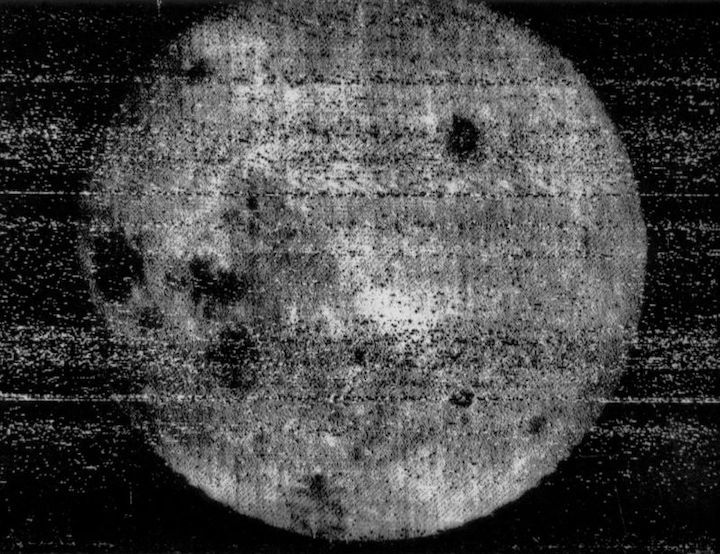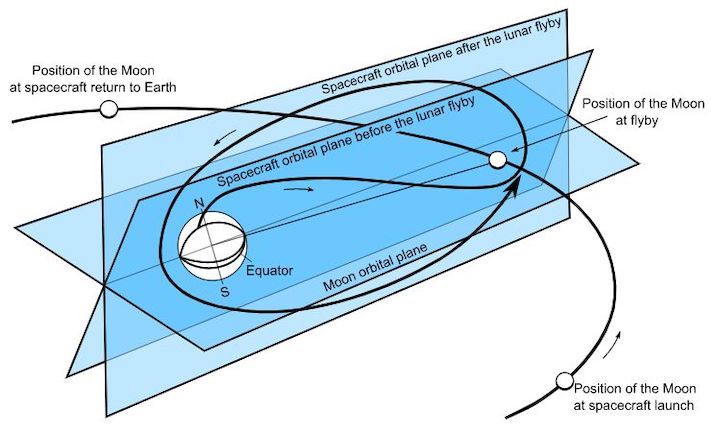6.10.2019

The first image returned by Luna 3 to Earth
To the extent that most people think about spaceflight before NASA's Apollo program, they probably remember the flights of Yuri Gagarin or Alan Shepard, or perhaps the launch of Sputnik on this date in 1957. But between Sputnik and the first human launches, the Soviet Union flew a lunar exploration program that was remarkable for its time.
In 1959, the Soviet Luna program launched three missions that, to one degree or another, were successful. Luna 1 became the first spacecraft to enter a heliocentric orbit, Luna 2 struck the Moon, and Luna 3—quite incredibly, for the time—captured photos of the far side of the Moon and returned them to Earth. This final mission, Luna 3, launched sixty years ago today on a converted intercontinental ballistic missile from the Baikonur Cosmodrome.
To understand the magnitude of this success, recall that most satellites launched during this era failed to reach orbit successfully. At the time, the United States had only launched about half a dozen satellites into orbit around the Earth, and most of these weighed between 10 and 20kg. By October, 1959, the United States had attempted to launch four spacecraft toward the Moon. Three had not come close. One, Juno II, passed within 60,000km of the Moon in 1958.
By contrast, Luna 3 was much larger than any spacecraft lofted by the United States, with a mass of 278.5kg. And the lengths to which it went to return even fuzzy, black-and-white images of the far side of the Moon are impressive.
Taking a picture
To capture a photograph of the far side of the Moon—which humans had never seen because the Moon is tidally locked to the Earth—Soviet engineers had to develop several new technologies for their spacecraft. First they had to stabilize the spacecraft so that it could take a clear picture.
The most simple way to stabilize a spacecraft is to spin it like a top, called spin stabilization. This won't work very well for a photograph, however, so the Soviets built the first spacecraft with three-axis stabilization. This means that, during the portion of time around the Moon, it activated reaction wheels to control its orientation.

Luna 3 gravity assist maneuver.
After the spacecraft reached a distance of 6,200km from the Moon's surface, it started this three-axis stabilization process. Then, it began capturing photos on temperature-resistant, radiation-hardened film. But this was only the first step toward getting photos back to Earth. "It gets wilder," Kevin Hainline, an astronomer, enthusiastically explained on Twitter. "Because these photos were then moved to a little chemical plant to develop and dry them. That's right, Luna 3 had a little 1 Hour Photo inside." Luna 3 captured a total of 29 photos, covering about 70% of the far side of the Moon.
Once developed, the photos were then transferred into a spot scanner, which used a cathode ray tube to convert the images into an electric signal. At this point the spacecraft was too far from Earth, so it somehow had to return back to Earth, something no spacecraft had done from the Moon.
Gravity assist
To fly back toward Earth, Luna 3 performed the first gravity assist maneuver by a human-built vehicle. Luna 3's trajectory and orbital plane were adjusted by the Moon's gravity just enough so that the spacecraft would fly by Earth over the Northern Hemisphere, passing over Soviet ground stations. During this time, the spacecraft transmitted 17 photographs to the ground.
The resulting photographs were of poor quality, but they revealed a mountainous far side of the Moon far different from the near side so familiar to anyone who has looked into the night sky. Contact with the probe was lost a few days later.
It is remarkable that this entire sequence of events unfolded with success. After Luna 3, the next 14 Soviet and US missions launched to the Moon, from 1959 through 1964, all failed due to rocket or spacecraft issues. The next success would not come until NASA's Ranger 7 mission impacted the surface of the Moon. By then the Cold War space race was well and truly on, which NASA would eventually win. But that should not distract from the amazing early feats of the Soviets.
Quelle: arsTechnica

